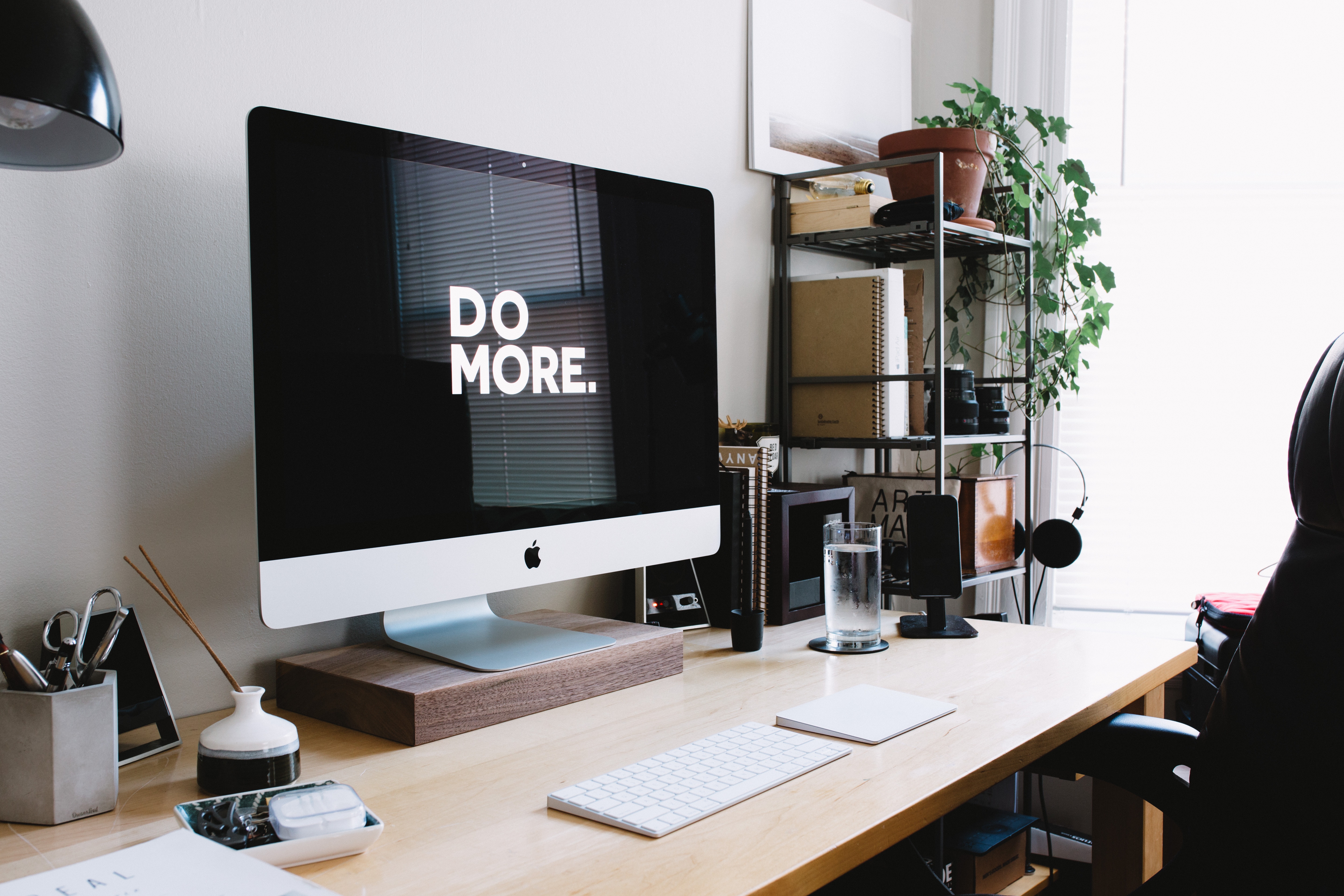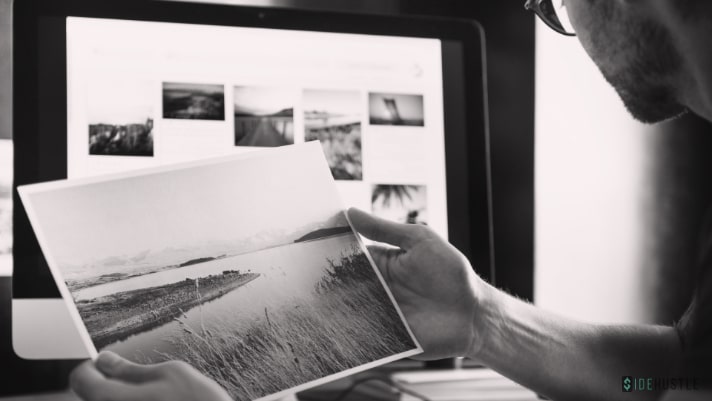There are a lot of side hustles out there to choose from. One possible opportunity, if you have the right skillset (or a natural eye for design and the desire to learn) is to become a freelance graphic designer. Freelance designers work with various businesses, providing them with visual designs that clearly communicate an intended message. As a graphic designer, you might design logos, catalogs, letterheads, business cards, websites, or apps, among other things. It’s a wonderful side hustle you can into right away, especially with a little experience under your belt.
1) Learn the Skills and Practice Them Frequently
You don’t have to have a degree in graphic design to become a freelance designer … though we won’t deny that it certainly helps. What you do need is a working knowledge of various design tools, as well as an eye for visual design elements.
It's a supremely funny thing. The MORE I practice, the luckier I get. #SideHustle #PracticeMakesPerfect Click To TweetIf you don’t already have a degree in design (and, like most people, don’t have the time, money or desire to go back to school), there are plenty of options for learning the skills you need. Aside from reading books on the subject there are many online courses you take, including Lynda, Treehouse, SkillShare, or Udemy. If you can’t afford to pay for courses, there are also plenty of helpful YouTube tutorials available.
Whether you are a seasoned designer or just starting out, another great way to polish your skills is to look at work other designers have done. Try browsing designs on Pinterest, studying business cards, looking at pamphlets, or analyzing websites. Design is all around you. Taking the time to examine any designs you see will help you gain inspiration, as well as teach you what works — as well as what doesn’t.
Above all, remember that practice makes perfect. Even if you aren’t getting paid gigs yet, find ways to practice your design skills. The more you design, the more refined your skill set will be and the easier it will be to build a successful side hustle.

2) Build a Portfolio
It’s the greatest Catch-22 in the world, isn’t it? To get work, you need experience … and to get experience, you need work. Having a portfolio is incredibly important to getting hired as a freelance graphic designer — but fortunately, you don’t actually need to get paid gigs to build one. You can (and should) start building your portfolio before you land your first gig!
One way to do this is to take on unpaid work. It may seem counter intuitive, but doing work for free can actually help you get paid in the long run — especially when you are just starting out. Try asking friends if they need anything designed, or approach businesses in your area to see if they offer internships. If all else fails, you can create mock-up designs for make-believe companies.
FUN BUREAU OF LABOR STAT: The median annual wage for graphic designers was $50,370 in May 2018. #SideHustle #GraphicDesigner Click To TweetOnce you have a solid collection of work (at least five pieces), you are ready to begin looking for paid work. As you complete more and more paid projects, you can replace items in your portfolio so that it always showcases your best and most recent work.
3) Know Your Ideal Client
Your next step in becoming a freelance designer is to get to know your ideal client. It may be tempting to try and market yourself as a jack-of-all-trades, but attempting to do so will only weaken your self-promotion. Instead, try targeting a specific market or niche. This will help you stand out and will also allow you to focus on a particular audience.
Picking a target market can be difficult. To start, write down a list of things that interest you. Maybe you really want to design for sports companies or for businesses in the pet vertical. Maybe you enjoy designing fashion spreads, or want to help small businesses. It doesn’t matter what your target market is, as long as it is something you find both interesting and meaningful.
Once you have picked a market, it is time to get to know your clients. Some questions to ask yourself include: What do they need? What particular challenges do they face? More importantly, how can you help them with these challenges? What do you have to offer that is unique?

4) Consider Specializing
Specializations can be both vertical (by industry or niche), or horizontal (by product). For example, you could specialize vertically in healthcare, and horizontally in logos and websites. Specializing increases the effectiveness of your self-promotion by establishing you as an expert in that particular area. It will also allow you to charge more (because of your expertise) when taking on projects within your area of specialization.
In the beginning, specializing horizontally can be especially useful because it allows you to become very good in a particular category. If you decide to specialize in creating business logos, for example, you free yourself up to focus your time and energy on practicing and perfecting logo design. Horizontal specialization can also help you to develop your personal design style.
5) Learn How to Market Yourself … And Then do so Consistently
So you have picked a market and decided on a specialization, now all you need is to open up shop and clients will come pouring in, right?
Not so fast.
To get clients and pick up jobs, you will need to learn not only how to market yourself, but also to do so consistently. The marketing work you do today will be what generates the work you are getting a year from now. In other words, even when the jobs start flooding in, consistent and effective self-promotion will always be your side hustle’s life blood. Here are some strategies you can try:

- Build your presence on social media. Instagram and Pinterest are both highly visual platforms that work well for showing off your designs, while Facebook and Twitter are great places for connecting with potential clients.
- Set up a (well-designed) website to house your portfolio. Beyond a simple portfolio, starting a blog that discusses design (or any other topic that will interest your ideal client) will help bring your portfolio traffic.
- Job searching. Search online job boards for postings, as well as freelance sites like Upwork and Fiverr.
- Email businesses within your market who could benefit from your services. While it may be scary to reach out, sending out cold pitches is one of the best ways to get new leads. The worst thing they can say is no!
6) What You Will Need
Beyond a reliable computer, there are several tools that you will need for your design work. First, and most importantly, you will need a handful of design programs to create your graphics. While you can find free versions on the web, Adobe Creative Cloud, though expensive, is well worth the investment. At the very least, having InDesign, Illustrator, and Photoshop at your disposal is extremely important for any professional designer, as these programs are standard for the industry.
A quality printer and scanner is also extremely important. Other useful tools, but nonessential tools include a sketch book and pen (or pencil), and a drawing tablet.
Conclusion
Getting started as a freelance graphic designer requires a fair amount investment upfront, both in education, tools, and time. If you are willing and able to take the plunge, however, starting a side hustle as a freelance designer can be both fulfilling and fun, as well as help bring in that little bit of extra cash.


